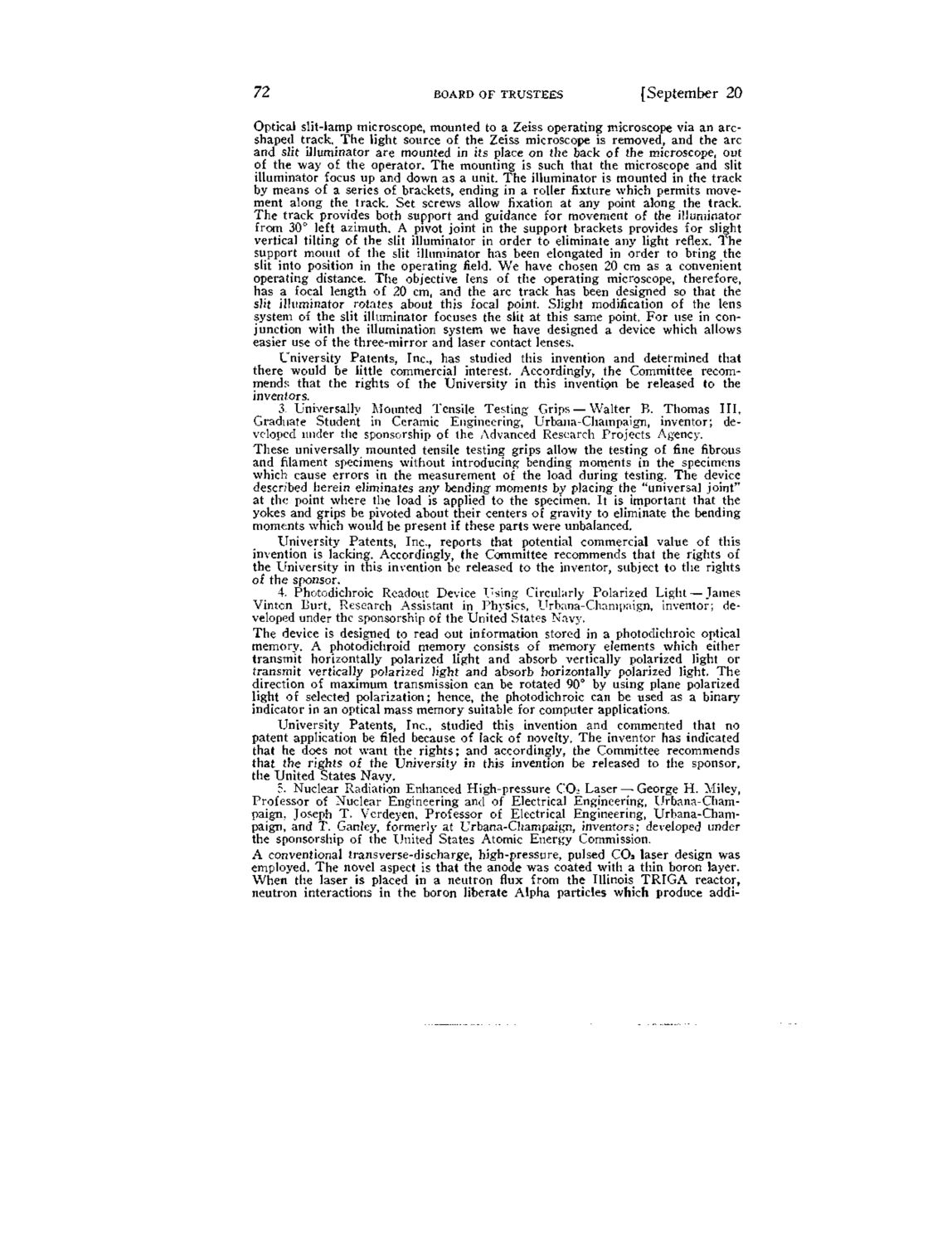| |
| |
Caption: Board of Trustees Minutes - 1974
This is a reduced-resolution page image for fast online browsing.

EXTRACTED TEXT FROM PAGE:
72 BOARD OF TRUSTEES [September 20 Optical slit-lamp microscope, mounted to a Zeiss operating microscope via an arcshaped track. The light source of the Zeiss microscope is removed, and the arc and slit illuminator are mounted in its place on the back of the microscope, out of the way of. the operator. The mounting is such that the microscope and slit illuminator focus up and down as a unit. The illuminator is mounted in the track by means of a series of brackets, ending in a roller fixture which permits movement along the track. Set screws allow fixation at any point along the track. The track provides both support and guidance for movement of the illuminator from 30° left azimuth. A pivot joint in the support brackets provides for slight vertical tilting of the slit illuminator in order to eliminate any light reflex. The support mount of the slit illuminator has been elongated in order to bring the slit into position in the operating field. We have chosen 20 cm as a convenient operating distance. The objective lens of the operating microscope, therefore, has a focal length of 20 cm, and the arc track has been designed so that the slit illuminator rotates about this focal point. Slight modification of the lens system of the slit illuminator focuses the slit at this same point. For use in conjunction with the illumination system we have designed a device which allows easier use of the three-mirror and laser contact lenses. University Patents, Inc., has studied this invention and determined that there would be little commercial interest. Accordingly, the Committee recommends that the rights of the University in this invention be released to the inventors. 3 Universally Mounted Tensile Testing Grips — Walter R. Thomas III, Graduate Student in Ceramic Engineering, Urbana-Chainpaign, inventor; developed under the sponsorship of the Advanced Research Projects Agency. These universally mounted tensile testing grips allow the testing of fine fibrous and filament specimens without introducing bending moments in the specimens which cause errors in the measurement of the load during testing. The device described herein eliminates any bending moments by placing the "universal joint" at the point where the load is applied to the specimen. It is_ important that the yokes and grips be pivoted about their centers of gravity to eliminate the bending moments which would be present if these parts were unbalanced. University Patents, Inc., reports that potential commercial value of this invention is lacking. Accordingly, the Committee recommends that the rights of the University in this invention be released to the inventor, subject to the rights of the sponsor. 4. Photodichroic Readout Device Using Circularly Polarized Light — James Vinton Eurt, Research Assistant in Physics, Urbana-Cham paign, inventor; developed under the sponsorship of the United States Navy. The device is designed to read out information stored in a photodichroic optical memory. A photodichroid memory consists of memory elements which either transmit horizontally polarized light and absorb vertically polarized^ light or transmit vertically polarized light and absorb horizontally polarized light. The direction of maximum transmission can be rotated 90" by using plane polarized light of selected polarization; hence, the photodichroic can be used as a binary indicator in an optical mass memory suitable for computer applications. University Patents, Inc., studied this invention and commented that no patent application be filed because of lack of novelty. The inventor has indicated that he does not want the rights; and accordingly, the Committee recommends that the rights of the University in this invention be released to the sponsor, the United States Navy. 5. Nuclear Radiation Enhanced High-pressure CO- Laser—-George H. Miley, Professor of Nuclear Engineering and of Electrical Engineering, Urbana-Champaign, Joseph T. Vcrdeyen, Professor of Electrical Engineering, Urbana-Champaign, and T. Ganley, formerly at Urbana-Champaign, inventors; developed under the sponsorship of the United States Atomic Energy Commission, A conventional trans verse-discharge, high-press ore, pulsed COa laser design was employed. The novel aspect is that the anode was coated with a thin boron layer. When the laser is placed in a neutron flux from the Illinois TRIGA reactor, neutron interactions in the boron liberate Alpha particles which produce addi-
| |